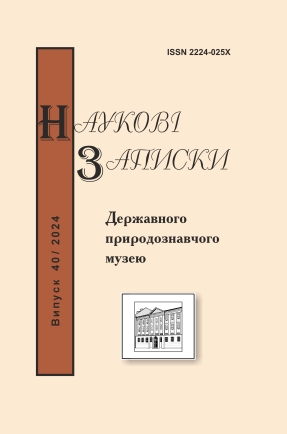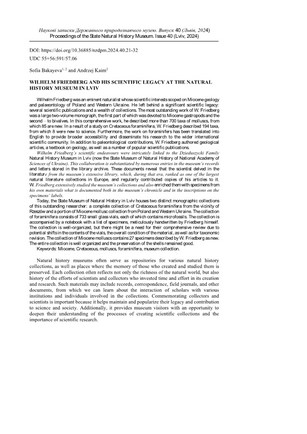Sofia Bakayeva, Andrzej Kaim
Wilhelm Friedberg and his scientific legacy at the Natural History Museum in Lviv // Proc. of the State Nat. Hist. Mus. - Lviv, 2024. - 40. - P. 21-32 DOI: https://doi.org/10.36885/nzdpm.2024.40.21-32 Key words: Miocene, Cretaceous, molluscs, foraminifera, museum collection. Wilhelm Friedberg was an eminent naturalist whose scientific interests scoped on Miocene geology and palaeontology of Poland and Western Ukraine. He left behind a significant scientific legacy: several scientific publications and a wealth of collections. The most outstanding work of W. Friedberg was a large two-volume monograph, the first part of which was devoted to Miocene gastropods and the second – to bivalves. In this comprehensive work, he described more than 700 taxa of molluscs, from which 85 are new. In a result of a study on Cretaceous foraminifera, W. Friedberg described 194 taxa, from which 8 were new to science. Furthermore, the work on foraminifers has been translated into English to provide broader accessibility and disseminate his research to the wider international scientific community. In addition to paleontological contributions, W. Friedberg authored geological articles, a textbook on geology, as well as a number of popular scientific publications.
Wilhelm Friedberg’s scientific endeavours were intricately linked to the Dzieduszycki Family Natural History Museum in Lviv (now the State Museum of Natural History of National Academy of Sciences of Ukraine). This collaboration is substantiated by numerous entries in the museum’s records and letters stored in the library archive. These documents reveal that the scientist delved in the literature from the museum’s extensive library, which, during that era, ranked as one of the largest natural literature collections in Europe, and regularly contributed copies of his articles to it. W. Friedberg extensively studied the museum’s collections and also enriched them with specimens from his own materials what is documented both in the museum’s chronicle and in the inscriptions on the specimens’ labels.
Today, the State Museum of Natural History in Lviv houses two distinct monographic collections of this outstanding researcher: a complete collection of Cretaceous foraminifera from the vicinity of Rzeszów and a portion of Miocene mollusc collection from Poland and Western Ukraine. The collection of foraminifera consists of 733 small glass vials, each of which contains microfossils. The collection is accompanied by a notebook with a list of specimens, meticulously handwritten by Friedberg himself. The collection is well-organized, but there might be a need for their comprehensive review due to potential shifts in the contents of the vials, the overall condition of the material, as well as for taxonomic revision. The collection of Miocene molluscs contains 27 specimens described by W. Friedberg as new. The entire collection is well organized and the preservation of the shells remained good.
Wilhelm Friedberg and his scientific legacy at the Natural History Museum in Lviv // Proc. of the State Nat. Hist. Mus. - Lviv, 2024. - 40. - P. 21-32 DOI: https://doi.org/10.36885/nzdpm.2024.40.21-32 Key words: Miocene, Cretaceous, molluscs, foraminifera, museum collection. Wilhelm Friedberg was an eminent naturalist whose scientific interests scoped on Miocene geology and palaeontology of Poland and Western Ukraine. He left behind a significant scientific legacy: several scientific publications and a wealth of collections. The most outstanding work of W. Friedberg was a large two-volume monograph, the first part of which was devoted to Miocene gastropods and the second – to bivalves. In this comprehensive work, he described more than 700 taxa of molluscs, from which 85 are new. In a result of a study on Cretaceous foraminifera, W. Friedberg described 194 taxa, from which 8 were new to science. Furthermore, the work on foraminifers has been translated into English to provide broader accessibility and disseminate his research to the wider international scientific community. In addition to paleontological contributions, W. Friedberg authored geological articles, a textbook on geology, as well as a number of popular scientific publications.
Wilhelm Friedberg’s scientific endeavours were intricately linked to the Dzieduszycki Family Natural History Museum in Lviv (now the State Museum of Natural History of National Academy of Sciences of Ukraine). This collaboration is substantiated by numerous entries in the museum’s records and letters stored in the library archive. These documents reveal that the scientist delved in the literature from the museum’s extensive library, which, during that era, ranked as one of the largest natural literature collections in Europe, and regularly contributed copies of his articles to it. W. Friedberg extensively studied the museum’s collections and also enriched them with specimens from his own materials what is documented both in the museum’s chronicle and in the inscriptions on the specimens’ labels.
Today, the State Museum of Natural History in Lviv houses two distinct monographic collections of this outstanding researcher: a complete collection of Cretaceous foraminifera from the vicinity of Rzeszów and a portion of Miocene mollusc collection from Poland and Western Ukraine. The collection of foraminifera consists of 733 small glass vials, each of which contains microfossils. The collection is accompanied by a notebook with a list of specimens, meticulously handwritten by Friedberg himself. The collection is well-organized, but there might be a need for their comprehensive review due to potential shifts in the contents of the vials, the overall condition of the material, as well as for taxonomic revision. The collection of Miocene molluscs contains 27 specimens described by W. Friedberg as new. The entire collection is well organized and the preservation of the shells remained good.
References
- Bieda F. 1949. Wilhelm Friedberg (1873-1941). Rocznik Polskiego Towarzystwa Geologicznego, 19 (1), pp. 27-32.
- Friedberg W. 1897. Przyczynek do znajomości otwornic kredowego marglu lwowskiego. Kosmos, 22, pp. 263-289.
- Friedberg W. 1901. Otwornice warstw inoceramowych okolicy Rzeszowa i Dębicy. Rozprawy Wydziału Matematyczno-Przyrodniczego Akademii Umiejętności. Serya 3, Tom 1, Dział B, Nauki Biologiczne, 41, pp. 601-668.
- Friedberg W. 1903. Atlas geologiczny Galicyi. Tekst do zeszytu szesnastego. Arkusze Rudnik i Raniżów (p. 3, sł. VII), Ropczyce i Dębica (p. 4, sł. VI), Rzeszów i Łańcut (p. 4, sł. VII). Wydawnictwo Komisyi Fizyjograficznej Akademii Umiejętności w Krakowie, Kraków, 147 p.
- Friedberg W. 1994. The foraminifera of the Inoceramus beds in the vicinity of Rzeszow and Dębica. In: Kaminski, M. A., Geroch, S. and Kaminski, D. (Eds.) The Origins of Applied Micropaleontology: The School of Jozef Grzybowski. Grzybowski Foundation Special Publication, no 1, pp. 163-195.
- Friedberg W. 1909. Rodzaj Turritella w miocenie ziem polskich. Rozprawy Wydziału Matematyczno-przyrodniczego Akademii Umiejętności w Krakowie. Seria B, 48, pp. 1-30.
- Friedberg W. 1911-1928. Mięczaki mioceńskie ziem polskich. Część I. Ślimaki. Zeszyt I-IV. Z. I: pp. 1-112 (1911); z. II: pp. 113-240 (1912); z. III: pp. 241-360 (1914); z. IV: pp. 361-440 (1923). Nakładem muzeum imienia Dzieduszyckich, Lwów – Poznań.
- Friedberg W. 1934-1936. Mięczaki mioceńskie ziem polskich. Część II. Małże. Zeszyt I-II, pp. 1-274. Kraków.
- Harzhauser M. & Landau B. 2019. Turritellidae (Gastropoda) of the Miocene Paratethys Sea with considerations about turritellid genera. Zootaxa 4681 (1), pp. 1-136. DOI: https://doi.org/10.11646/zootaxa.4681.1.1
- Harzhauser, M. & Landau, B. 2023. The Architectonicidae and Mathildidae (Gastropoda, Heterobranchia) of the Miocene Paratethys Sea-victims of the Miocene Climatic Transition. Zootaxa 5370 (1), pp. 1-74. DOI: https://doi.org/10.11646/zootaxa.5370.1.1
- Harzhauser, M.; Landau, B. M. 2024. The Colubrariidae, Eosiphonidae, Melongenidae, Pisaniidae, Prodotiidae and Tudiclidae (Gastropoda, Buccinoidea) of the Miocene Paratethys Sea. Zootaxa 5427 (1), pp. 1-110. DOI: https://doi.org/10.11646/zootaxa.5427.1.1
- Krach W. 1949. Z działalności naukowej prof. W. Friedberga. Rocznik Polskiego Towarzystwa Geologicznego, 19 (1): pp. 32-43.


